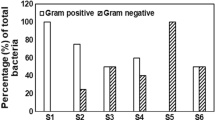Abstract
The microcosm method was used to demonstrate an increase in bacterial numbers and drastic changes in the taxonomic structure of saprotrophic bacteria as a result of mechanical grinding of Sphagnum moss. Eccrisotrophic agrobacteria predominant in untreated moss were replaced by hydrolytic bacteria. Molecular biological approaches revealed such specific hydrolytic bacteria as Janthinobacterium agaricum and Streptomyces purpurascens among the dominant taxa. The application of kinetic technique for determination of the physiological state of bacteria in situ revealed higher functional diversity of hydrolytic bacteria in ground moss than in untreated samples. A considerable decrease of the C/N ratio in ground samples of living Sphagnum incubated using the microcosm technique indicated decomposition of this substrate.
Similar content being viewed by others
References
Moore, O., The ecology of peat-forming processes: a review, Int. J. Coal Geol., 1989, vol. 12, pp. 89–103.
Aerts, R., Verhoeven, J.T.A., and Whigham, D.F., Plant-mediated controls on nutrient cycling in temperate fens and bogs, Ecology, 1999, vol. 80, no. 7, pp. 2170–2181.
Zavarzin, G.A., Lektsii po prirodovedcheskoi mikrobiologii (Lectures in Environmental Microbiology), Moscow: Nauka, 2003.
Thormann, M.N., Bayley, S.E., and Currah, R.S., Microcosm tests of the effects of temperature and microbial species number on the decomposition of Carex aquatilis and Sphagnum fuscum litter from southern boreal peatlands, Can. J. Microbiol., 2004, vol. 50, pp. 793–802.
Bambalov, N.N., Analysis of the hydrothermal hypothesis of organic matter decomposition, in Materialy IV nauchnoi shkoly “Bolota i biosfera” (Proc. 4th Sci. School “Bogs and Biosphere”), Tomsk: TsNTI, 2005, pp. 61–68.
Bambalov, N.N., Analysis of the biological factors of organic matter decomposition in bog environments, in Materialy V nauchnoi shkoly “Bolota i biosfera” (Proc. 5th Sci. School “Bogs and Biosphere”), Tomsk: TsNTI, 2006, pp. 18–27.
Funktsionirovanie mikrobnykh kompleksov verkhovykh torfyanikov — analiz prichin medlennoi destruktsii torfa (Functioning of Microbial Complexes of High-Moor Peatlands—Analysis of the Reasons for Slow Peat Decomposition), Moscow: Tov. Nauch. Izd. KMK, 2013.
Ivanov, A.A., Yudina, N.V., and Lomovskii, O.I., Mechanochemical treatment of high-moor pit, Khim. Rastit. Syr’ya, 2004, no. 2, pp. 55–60.
Metody pochvennoi biokhimii i mikrobiologii (Methods in Soil Biochemistry and Microbiology), Moscow: Mos. Gos. Univ., 1991.
Bergey’s Manual of Systematic Bacteriology, 8th ed., vols. 1–2, Holt, J.G., Ed., Baltimore-London: Williams and Wilkins, 1986.
Dobrovol’skaya, T.G., Golovchenko, A.V., Lysak, L.V., and Zenova, G.M., Fizikokhimiya i biologiya torfa. Metody otsenki chislennosti i raznoobraziya bakterial’nykh i aktinomitsetnykh kompleksov torfyanykh pochv: uchebnoe posobie (Physical Chemistry and Biology of Peat. Methods for Assessment of Abndance and Diversity of Bacterial and Actinomycete Complexes of Peat Soils), Tomsk: TGPU, 2010.
Manucharova, N.A., Vlasenko, A.N., Tourova, T.P., Panteleeva, A.N., Stepanov, A.L., and Zenova, G.M., Thermophilic chitinolytic microorganisms of brown semidesert soil, Microbiology (Moscow), 2008, vol. 77, no. 5, pp. 610–615.
Yakushev, A.V., Microbiological characterization of vermicomposts, Extended Abstract Cand. Sci. (Biol.) Dissertation, Moscow: Mos. Gos. Univ., 2009.
Dobrovol’skaya, T.G., Golovchenko, A.V., Kukharenko, O.S., Yakushev, A.V., Semenova, T.A., and Inisheva, L.I., The structure of the microbial communities in low-moor and high-moor peat bogs of Tomsk oblast, Euras. Soil Sci., 2012, vol. 45, no. 3, pp. 273–281.
Kukharenko, O.S., Pavlova, N.S., Dobrovol’skaya, T.G., Golovchenko, A.V., Pochatkova, T.N., Zenova, G.M., and Zvyagintsev, D.G., The influence of aeration and temperature on the structure of bacterial complexes in high-moor peat soils, Euras. Soil Sci., 2010, vol. 43, no. 5, pp. 573–579.
Kozhemyakov, A.P. and Tikhonovich, I.A., Agricultural application of leguminous inoculants and complex action biopreparations, Dokl. Ross. Akad. S.-kh. Nauk, 1998, no. 6, pp. 7–10.
Varma, A., Sherameti, I., Tripathi, S., Prasad, R., Das, A., Sharma, M., et al., The symbiotic fungus Piriformospora indica: review, in The Mycota, vol. 9. Fungal Associations, Hock, B., Ed., Springer; 2012, pp. 231–254.
Murugesan, S., Manoharan, C., Vijayakumar, I.R., and Panneerselvam, A., Isolation and characterization of Agrobacterium rhizogenes from the root nodules of some leguminous plants, Int. J. Microbiol. Res, 2010, vol. 1, no. 3, pp. 92–96.
Sawada, H., Ieki, H., Ovaiz, H., and Matsumoto, S., Proposal for rejection of Agrobacterium tumefaciens and revised descriptions for the genus Agrobacterium and for Agrobacterium radiobacter and Agrobacterium rhizogenes, Int. J. Syst. Bacteriol., 1993, vol. 43, no. 4, pp. 694–702.
Young, J.M., Kuykendal, L.D., Martinez-Romero, E., Kerr, A., and Sawada, H., A revision of Rhizobium Frank 1889, with an emended description of the genus, and the inclusion of all species of Agrobacterium Conn 1942 and Allorhizobium undicola de Lajudie et al. 1998 as new combinations: Rhizobium radiobacter, R. rhizogenes, R. rubi, R. undicola and R. vitis, Int. J. Syst. Bacteriol., 2001, vol. 51, pp. 89–103.
Author information
Authors and Affiliations
Corresponding author
Additional information
Original Russian Text © T.G. Dobrovol’skaya, A.V. Golovchenko, A.V. Yakushev, N.A. Manucharova, E.N. Yurchenko, 2014, published in Mikrobiologiya, 2014, Vol. 83, No. 6, pp. 712–721.
Rights and permissions
About this article
Cite this article
Dobrovol’skaya, T.G., Golovchenko, A.V., Yakushev, A.V. et al. Effect of mechanical grinding of Sphagnum on the structure and physiological state of bacterial communities. Microbiology 83, 820–828 (2014). https://doi.org/10.1134/S0026261714060058
Received:
Published:
Issue Date:
DOI: https://doi.org/10.1134/S0026261714060058



